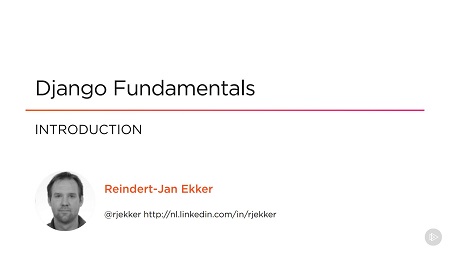
English | MP4 | AVC 1280×720 | AAC 44KHz 2ch | 3h 43m | 606 MB
This course teaches the basics of web development with the Django framework. You will learn everything you need to become a productive Python web developer.
Django is the most popular and most mature Python web development framework around. It makes it easy to build better Web apps more quickly and with less code. Building web sites with Django is not just smart and efficient, but fun too! In this course, Django Fundamentals, you will learn how to build a complete web application with Django. First, you’ll see how to create attractively styled pages using Django templates. Next, you’ll learn how to add URL mappings for these pages, and handle user interaction with forms. Finally, to store and manipulate data, Django offers a powerful model API and admin interface, and of course these are covered as well. After finishing the course, you will have a good overview of all the essential parts of Django and how they work together, so that you can go on and build your own websites in Django.
Table of Contents
01 – Course Overview
02 – Introduction
03 – About Django
04 – Django Design Principles
05 – Prerequisites
06 – The Demo Project
07 – Course Overview
08 – Module Overview
09 – Before You Start – Versions, Virtualenvs and Terminals
10 – Demo – Creating and Activating a Virtual Environment
11 – Review – Virtual Environments
12 – Demo – Installing Django
13 – Review – Installing Django
14 – Module Overview
15 – Demo – Starting and Running a Django Project
16 – Demo – Opening Your Project in PyCharm
17 – Review – Starting and Running a Django Project
18 – Demo – Adding a Simple Page
19 – Review – Startproject, Views, and URL Mappings
20 – New Concepts – Apps, Models, Migrations
21 – Demo – Running Initial Migrations
22 – Demo – Creating an App
23 – Demo – Adding Your Own Models
24 – Demo – Creating and Running Migrations
25 – Demo – Another Migration
26 – Review – Apps, Models, Migrations
27 – Summary
28 – Module Overview
29 – Demo – The Django Admin Site
30 – Demo – Django Models and _str_()
31 – Demo – Customizing the Admin with a ModelAdmin Class
32 – Review – The Admin Interface
33 – Demo – The Model API
34 – Demo – QuerySets and Laziness
35 – Review – The Model API
36 – Module Overview
37 – Demo – Django Templates
38 – Review – Django Templates
39 – Demo – Passing Data from View to Template
40 – Demo – Displaying Game Data in a Template
41 – Demo – A Custom Model Manager and Q()
42 – Review – Templates and Data
43 – Demo – Static Content
44 – Demo – A Base Layout and Template Inheritance
45 – Demo – Top-level Content Folders
46 – Review – Static Content and Template Inheritance
47 – Module Summary
48 – Module Overview
49 – Demo – Reacting to the User’s Login Status and Redirecting
50 – Demo – Login and Logout Views
51 – Review – Authentication
52 – Demo – Showing an Invitation Form
53 – Forms – General Flow
54 – Demo – Handling Form Submit
55 – Review – ModelForms, Views, and Validation
56 – Demo – Accepting Invitations
57 – Review – Named Groups and get_or_404()
58 – Demo – Tuning and Styling Forms
59 – Summary
60 – Module Overview
61 – Demo – A Game Detail Page
62 – Demo – Displaying the Game
63 – Demo – A Form for Making Moves
64 – Demo – Validating the Move Form
65 – Demo – Overriding Save() on the Move Class
66 – Demo – Template Includes
67 – Review
68 – Demo – Class Based Views – Showing All Games with ListView
69 – Demo – Class Based Views – User Signup with CreateView
70 – Module Summary
Resolve the captcha to access the links!